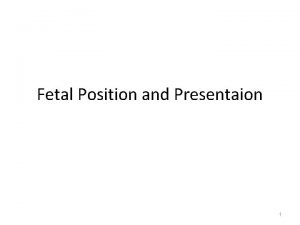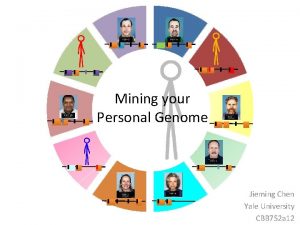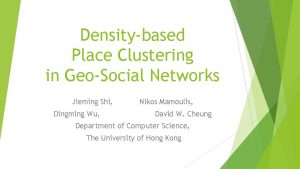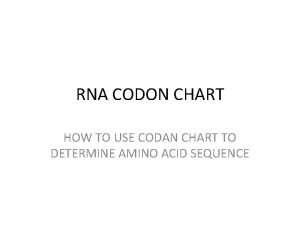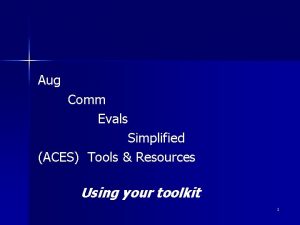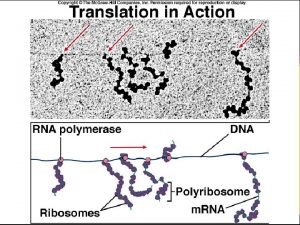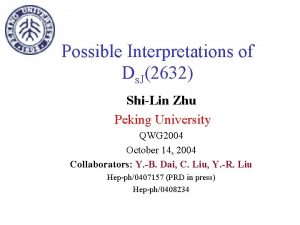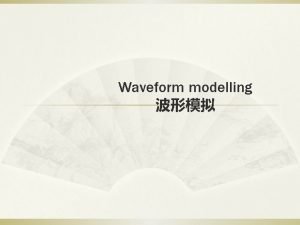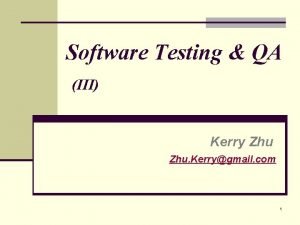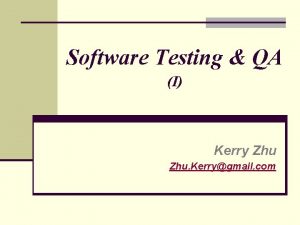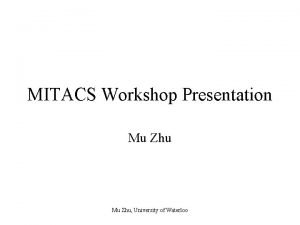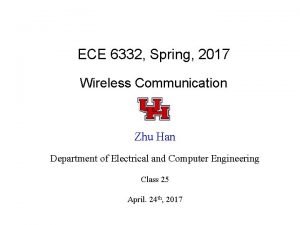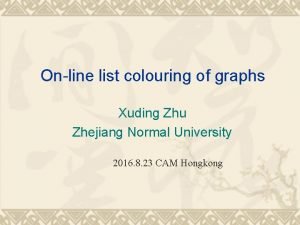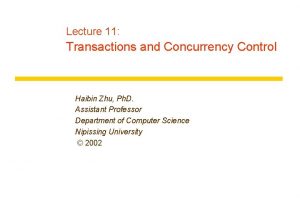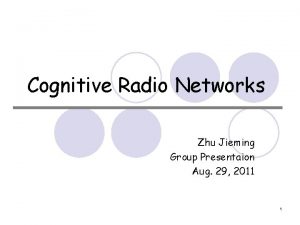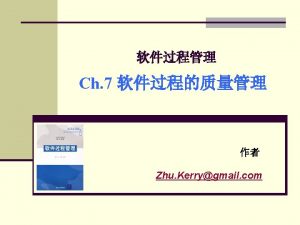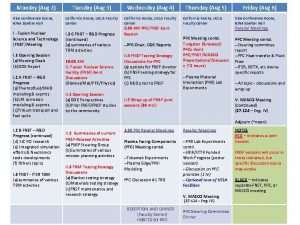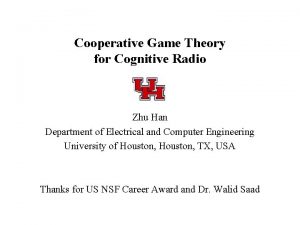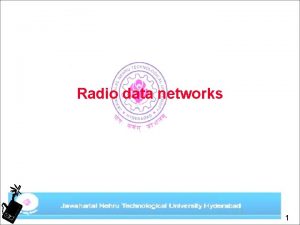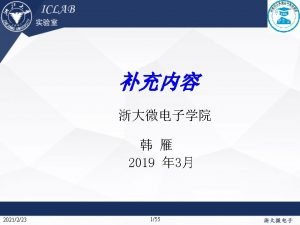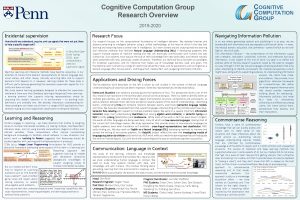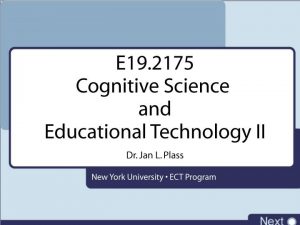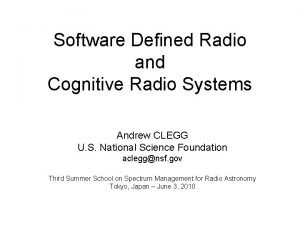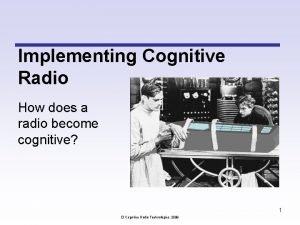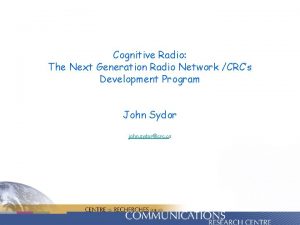Cognitive Radio Networks Zhu Jieming Group Presentaion Aug

























- Slides: 25

Cognitive Radio Networks Zhu Jieming Group Presentaion Aug. 29, 2011 1

Outline l 1. Wireless mobile communication l 2. Introduction to cognitive radio networks l 3. Dynamic spectrum management l 4. Interference mitigation l 5. Summary 2

1. Wireless mobile communication l The development of wireless mobile communications 1 G 2 G 2. 5 G 2. 75 G 3 G 4 G l Directions for development High data rate Broadban d Heterogeneit y Ubiquity 3

1. Wireless mobile communication 1 G 2 G 2. 5 G 2. 75 G 3 G 4 G 1 G: l Analog mobile phone l FDMA (Frequency Division Multiple Access) l Low system capacity and security problems 4

1. Wireless mobile communication 1 G 2 G 2. 5 G 2. 75 G 3 G 4 G 2 G: l GSM (Global System for Mobile Communications) l TDMA (Time Division Multiple Access) l SMS (Short Message Service) l Data Rate: 9. 6 kbps 5

1. Wireless mobile communication 1 G 2 G 2. 5 G 2. 75 G 3 G 4 G 2. 5 G/2. 75 G: l Circuit switch Packet switch l 2. 5 G: GPRS (General Packet Radio Service) l 2. 75 G: EDGE (Enhanced Data Rate for GSM Evolution) l Data Rate: 384 kbps 6

1. Wireless mobile communication 1 G 2 G 2. 5 G 2. 75 G 3 G 4 G 3 G: l CDMA (Code Division Multiple Access) l Data Rate: 2. 4 Mbps 3 G Standards • WCDMA (Europe) • CDMA 2000 (America) • TD-SCDMA (Datang, China) 7

1. Wireless mobile communication 1 G 2 G 2. 5 G 2. 75 G 3 G 4 G 4 G(Standardization is on-going): l OFDMA (Orthogonal Frequency Division Multiple Access) l Wi. Max (Worldwide Interoperability for Microwave Access)/ LTE (Long Term Evolution for 3 G ) § Based on an all-IP packet switched network § Vo. IP(Voice over Internet Protocol ) § Peak data rates up to 100 Mbps for high mobility and 1 Gbps for low mobility. l LTE networks in Universiade Shenzhen: 50 Mbps 8

1. Wireless mobile communication l Challenges in future wireless communications Problems in future wireless networks Scarcity of radio frequency Low spectrum utilization Increasing demand for spectrum Heterogeneous networks 9

1. Wireless mobile communication l We should have a technology that § can solve the scarcity of available spectrum § can satisfy the increasing spectrum requirement for wireless service § and can communicate seamlessly over the heterogeneous networks l CR(Cognitive Radio) and CRN(Cognitive Radio Networks) are proposed… 10

2. Introduction to CRNs l CR is defined as a radio that can change its transmitter parameters according to the interactions with the environment in which it operates. SDR Cognitive Radio Networks l CR is based on the platform of software definition radio(SDR) which can easily reconfigure itself without changing any hardware. 11

2. Introduction to CRNs l Features of CR § Cognitive capability ü Detect the spectrum holes and occupy the spectrum to enhance the data rate and spectrum utilization ü Support seamless handoff to optimize the performance among the heterogeneous networks of GSM, Wi. Max, LTE… § Reconfigurability ü Dynamically change the transmitter frequency, power and modulation parameters to adapt to the environment l CR is a hot research issue and faced with a lot of challenges. 12

2. Introduction to CRNs l Challenges of CR § Cognition Information Detection ü Spectrum Sensing § Cognition Information Processing and Decision ü Dynamic spectrum management ü Radio Resource Management § Reconfigurable Protocols § System architecture of CRNs 13

3. Dynamic spectrum management l Scarcity of spectrum vs. low spectrum utilization l DSM(Dynamic Spectrum Management ) is proposed to enhance the spectrum utilization 14

3. Dynamic spectrum management l DSM vs. FSM (Fixed spectrum management ) Dynamic spectrum allocation and sharing DSM vs. FSM Optimize the spectrum utilization Maximize the system capacity 15

3. Dynamic spectrum management l Steps for DSM § Spectrum sensing: § Spectrum decision: § Spectrum sharing: § Spectrum mobility: detect the spectrum holes model for choose the best available spectrum channel share the spectrum with primary users leave the channel occupied and find another suitable channel for communication Primary user; Cognitive user; Spectrum holes 16

3. Dynamic spectrum management l Challenges in research of DSM: spectrum decision, wideband spectrum sensing, Qo. S awareness, seamless handoff, hardware support. . . l Interference mitigation is one of the most important challenges for research. 17

4. Interference Mitigation l Interference Scenarios § Interference between primary users and cognitive users ü It’s difficult to detect the status of PUs, So it may interfering PUs when they occupy the spectrum again. § Interference among cognitive users ü When several CUs access the spectrum holes of one PU, there exists interference among CUs. 18

4. Interference Mitigation l Coloring graph model l PU: Ⅰ~Ⅳ l CU: 1~5 l Channels: A, B, C l Interference range of PUs l Interference of CUs 19

4. Interference Mitigation l Interference mitigation between PUs and CUs l If the CU is in the interference range of a PU, the CU can’t 20 use the channel which the PU is occupied.

4. Interference Mitigation l Interference mitigation among CUs l If there exists interference between CUs, there exists an edge between them and they can’t use a channel simultaneously. 21

4. Interference Mitigation l Interference graph and coloring model C A C C B l Coloring: Taking the each channel as one color, then color the vertexes with available colors, and the neighbor vertex can’t be colored with one color. 22

4. Interference Mitigation l Spectrum allocation algorithms § Greedy algorithm: maximize the spectrum utilization § Fair algorithm: maximize the fairness among cognitive users § Random algorithm: lower complexity and time delay 23

5. Summary l The development of wireless mobile communications l The advances of cognitive radio networks l Challenges in dynamic spectrum management l Coloring graph based interference mitigation 24

Thank you! 25
 Kaizen meaning
Kaizen meaning Cephalic presentaion
Cephalic presentaion Genome.gov
Genome.gov Jieming shi
Jieming shi Words with the root gon
Words with the root gon Aug methionine start codon
Aug methionine start codon Ucag chart
Ucag chart Kaligiran ng el filibusterismo
Kaligiran ng el filibusterismo Aug q
Aug q Aug comm device
Aug comm device Transkripsjon og translasjon
Transkripsjon og translasjon Cognitive and non cognitive religious language
Cognitive and non cognitive religious language Datagram switching vs virtual circuit
Datagram switching vs virtual circuit Backbone networks in computer networks
Backbone networks in computer networks Conventional radio system
Conventional radio system Ds peking
Ds peking Lupei zhu
Lupei zhu Zhe yi sheng zui mei de zhu fu lyrics
Zhe yi sheng zui mei de zhu fu lyrics Kerry zhu
Kerry zhu The code and fix model
The code and fix model Man wo
Man wo Axing zhu
Axing zhu Mitacs waterloo
Mitacs waterloo Zhu han
Zhu han Xuding zhu
Xuding zhu Haibin zhu
Haibin zhu

